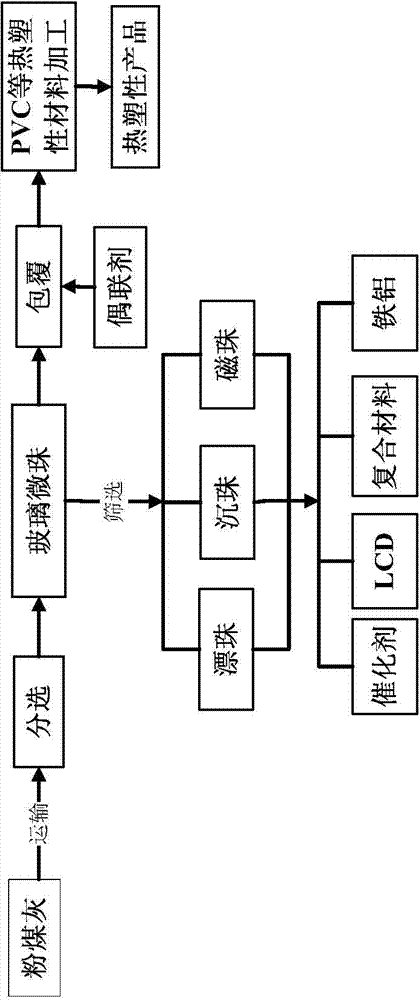Method for simultaneously extracting glass microbeads from fly ash and coproducing aluminum-silicon-iron alloy and white carbon black
A technology of glass microspheres and fly ash, which is applied in the field of waste resource recycling to reduce production costs, improve people's lives, and solve the effects of surface subsidence
- Summary
- Abstract
- Description
- Claims
- Application Information
AI Technical Summary
Problems solved by technology
Method used
Image
Examples
Embodiment 1
[0044] Such as figure 2As shown, the fly ash is transported from the self-provided power plant to the sorting workshop and separated by a wind classifier to obtain glass beads, carbon powder and residual ash, and the obtained glass beads are further obtained by gravity separation, flotation, and magnetic separation beads, Shen beads and magnetic beads. Among them, the floating beads and sinking beads are coated with silane or titanate coupling agent accounting for 2-5% of the weight of the floating beads or sinking beads. (For example, take 100kg of floating beads or sinking beads, add 2~5kg of coupling agent) and use them as high-grade fillers after treatment (magnetic beads in glass microspheres can also be coated as fillers, but the effect is not as good as floating beads and sinking beads) , added to PVC (polyvinyl chloride), PP (polypropylene), PE (polyethylene), PS (polystyrene) and other thermoplastic materials for processing and modification, to produce different PVC...
Embodiment 2
[0048] Such as figure 1 As shown, the power plant fly ash is sorted to obtain floating beads, sinking beads, magnetic beads, carbon powder and residual ash. Take 100kg of floating beads, mix 2~5kg of silane and titanate coupling agent, and carry out coating treatment. As a high-grade filler, add it to PVC (polyvinyl chloride), PP (polypropylene), PE (polyethylene), PS (polystyrene) and other thermoplastic materials. Shenzhu is sieved to select a particle size of 200 mesh or more, which is coated according to the above method or directly added to thermoplastic products such as PVC, PP, PE, PS, etc., which is conducive to improving the mechanical properties and heat resistance of the product and reducing costs.
[0049] Mix 15kg of magnetic beads, 40kg of carbon powder, 25kg of residual ash, 9kg of clay, and 10kg of water (you can also add coal slime to provide carbon, bauxite to provide aluminum, silica to provide silicon and other raw materials), and roll and mix; mix well a...
PUM
| Property | Measurement | Unit |
|---|---|---|
| particle diameter | aaaaa | aaaaa |
| particle size (mesh) | aaaaa | aaaaa |
| diameter | aaaaa | aaaaa |
Abstract
Description
Claims
Application Information
 Login to View More
Login to View More - R&D Engineer
- R&D Manager
- IP Professional
- Industry Leading Data Capabilities
- Powerful AI technology
- Patent DNA Extraction
Browse by: Latest US Patents, China's latest patents, Technical Efficacy Thesaurus, Application Domain, Technology Topic, Popular Technical Reports.
© 2024 PatSnap. All rights reserved.Legal|Privacy policy|Modern Slavery Act Transparency Statement|Sitemap|About US| Contact US: help@patsnap.com









